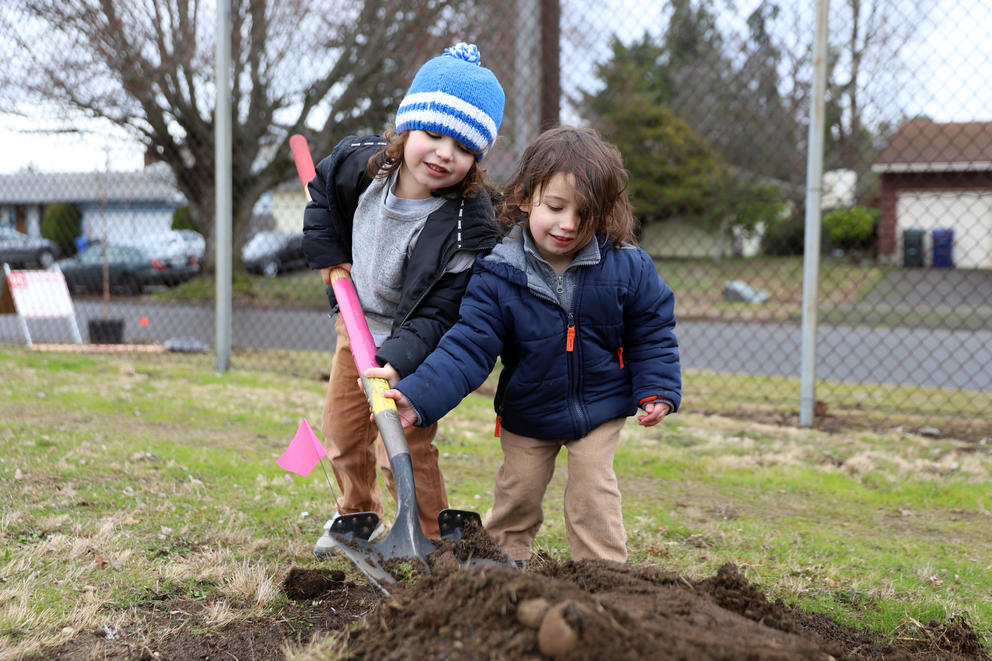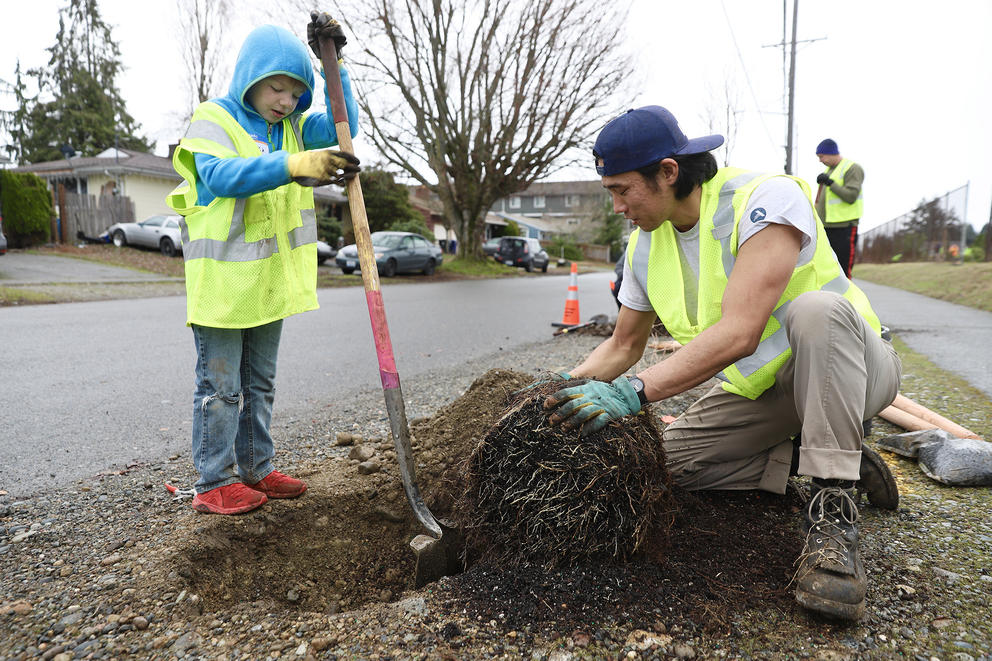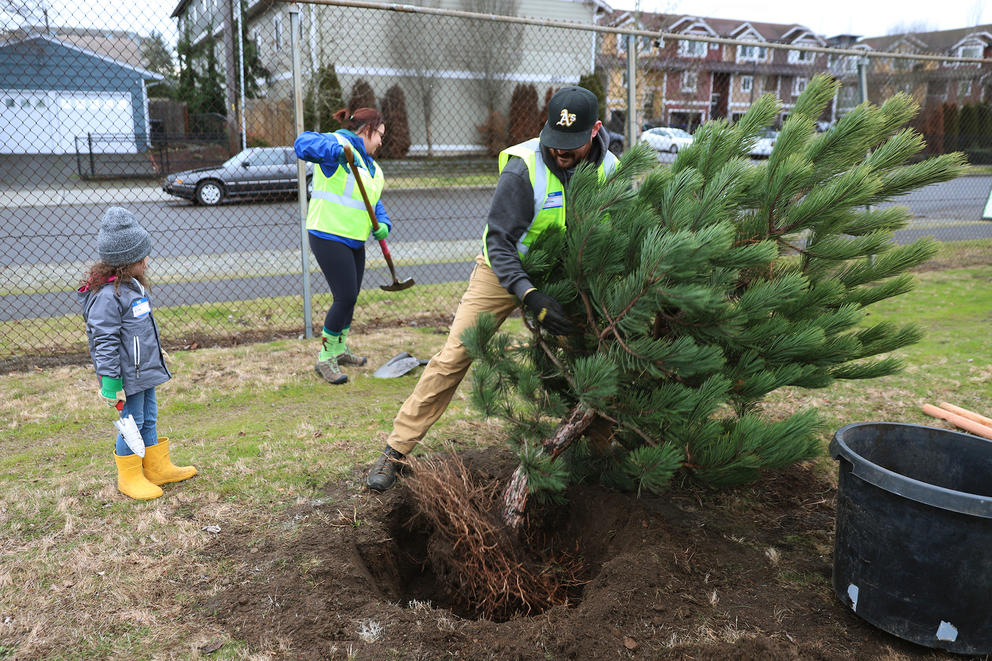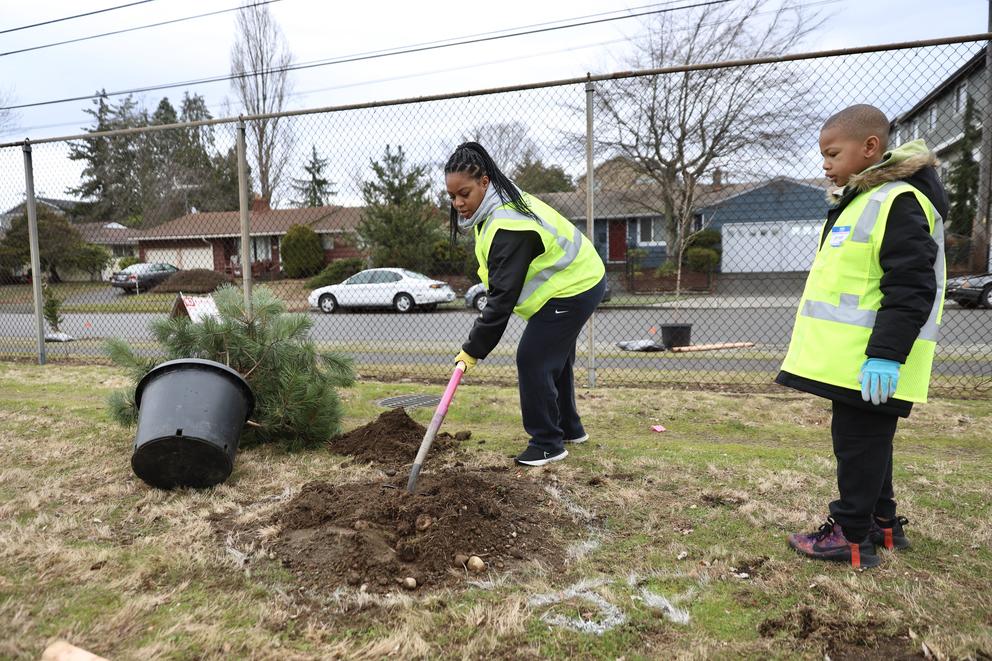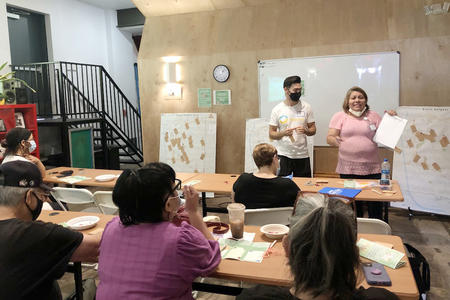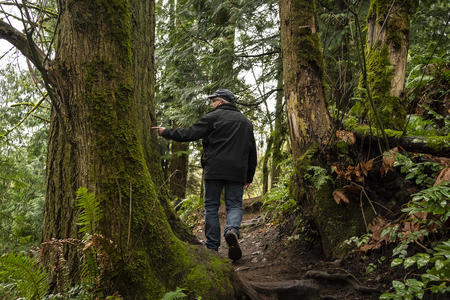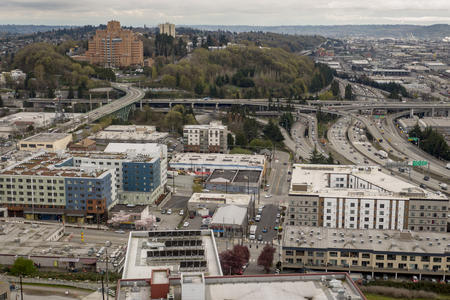Digging on school property might earn some toddlers a timeout, but in this case Sol and Chili are providing a public service. Fifty-eight trees, including the roughly 6-foot-tall tree in the soil-filled bucket beside them, were planted in the field on Feb. 4 as part of a tree-canopy improvement project in one of Tacoma’s most treeless and fastest-growing communities.
Climate change, pollution and growing mental and physical health crises are highlighting the importance of green spaces for everyone and the scarcity of urban trees.
“With temperatures rising and health and economic disparities widening, trees are no longer a ‘nice to have.’ They are a must-have. We have a moral responsibility right now to truly address the wrongs of the past and create an opportunity not just for some, but for all in the future,” said DNR Commissioner Hilary Franz at the tree planting.
With the help of a Washington Department of Natural Resources grant funneling funds from the U.S. Forest Service, Tacoma and its nonprofit partners, local artists and Tacoma Mall residents are creating more green space in a part of town that desperately needs it. At the same time, they’re hoping to drive more funds toward equitably expanding urban tree canopies around the state.
The not-quite-Evergreen State
Washington often defines itself by its forests, but many urban areas like Tacoma and Seattle have been stripped of trees and paved over.
“Tacoma already has the worst canopy coverage of any of the cities in the Puget Sound region. We're at 20 percent. It's pretty sad,” said Tacoma urban forestry analyst Ryan Hebert. To reach its tree-canopy goal of 30% citywide, Tacoma needs to plant one million trees, said Tacoma Tree Foundation executive director Lowell Wyse. And they’re depending on volunteers like Sol and Chili to do some of the work.
The dearth of canopy coverage has contributed to environmental health problems only made worse by climate change: Urban forests temper extreme temperatures, shade salmon streams, reduce stormwater runoff, create wildlife habitat, boost air quality, improve people’s well-being and make cities generally more comfortable and beautiful. And the areas suffering most from environmental health disparities are disproportionately low-income with racially diverse residents, something made easily visible by the state’s Environmental Health Disparities Map.
The Tacoma Mall neighborhood’s tree-canopy coverage is less than half the city average. Parks and open spaces make up only 1% of its land area, and 70% of the neighborhood is covered by cement, asphalt, buildings and other impervious surfaces. Residents who live here have a poverty rate of 31% and an average life expectancy nine years lower than the county average. A historically redlined area, Tacoma Mall illustrates the results of decades of under-resourcing.
Marisa, Brian and Ellie Caughlan plant a tree at the Madison Complex in Tacoma Mall as part of a community engagement project working on tree-canopy expansion, led by the Tacoma Tree Foundation with funding from the Washington State Department of Natural Resources and the U.S. Forest Service. (Hannah Weinberger/Crosscut)
Actually doing something about this required more resources than the city alone could provide. Yet the need was severe: Tacoma Mall, a designated Regional Growth Center, is destined to become one of the most population-dense neighborhoods in the Puget Sound region. More housing and businesses are inducing more people to share already-sparse green spaces.
Those green spaces include a tiny north-end park with a playground near Costco, called Lincoln Heights Park; South Park, the only true park in the Tacoma Park neighborhood; and Wapato Hills Park, a similarly sized park that’s accessible but outside the neighborhood’s boundaries. In between, the closest thing to a park is the Madison Complex, Hebert said. Madison, where green space amounts to a nice playground and a field, currently houses a few early-learning classes.
Five years ago, however, the city and the then-newly formed Tacoma Tree Foundation found a small yet significant financial lifeline in the Department of Natural Resource’s Urban and Community Forestry Program. The program provides grants for cities whose forestry plans need help — or need designing, period — with the intention of increasing community buy-in and support around urban forestry over the long term, said program manager Ben Thompson. It prioritizes grants those communities that score high on an environmental health disparities ranking.
Thompson’s team has supported more than 200 programs using at least $2.6 million in U.S. Forest Service dollars since 2008, with demand for grants increasing over time. DNR gave out $550,000 in grants in the most recent grant cycle, but that still met only about half the expressed need, Thompson said.
In 2018, DNR channeled $170,000 from the U.S. Forest Service into a landscape restoration grant to Tacoma Mall. It complemented a green infrastructure project and subarea plan put in motion to help Tacoma Mall prepare sustainably for anticipated growth. The money paid for, among other things, 300 trees, a tree-canopy analysis, a neighborhood-level urban-forest management plan and an effort to identify places where more trees could be planted — things that could help the city do more and better tree care down the line. It also funded the Tacoma Tree Foundation’s neighborhood-level work. Executive Director Wyse said the grant was the organization’s first steady income source.
Subcontracting community engagement work to the Tacoma Tree Foundation not only gave the city credibility with locals, Hebert said, but strengthened the foundation and set it on a path to do similar work elsewhere.
The grant funding also birthed the Green Blocks program, in which the foundation persuaded residents to plant 75 street trees. Grant-funded activities also inspired a research project to monitor how those trees affect the neighborhood’s ambient temperature and evaluate people’s relationships with those trees.
“In a lot of ways it was just seed money for the work that's been accomplished since, because it has really inspired additional investments from other organizations,” DNR’s Thompson said.
Putting down roots at home
In the wake of local artists’ tree-themed art installations and projects involving the school, the school district and the city greenlit the foundation’s Madison Complex tree-planting project two months ago.
Artist, Tacoma resident and wildland firefighter Alex Schelhammer made art installations and tree giveaways to help locals learn about trees and forestry grants. “It was important to be here because somebody needed to come and talk to and be a part of the change for the people,” he said.
When Sol, Chili and dozens of other volunteers descended on the school on Feb. 4, they were accompanied by celebratory officials like State Sen. Yasmin Trudeau and DNR’s Franz, whose department is asking for $8 million for the urban forestry program this legislative cycle.
Getting to plant at the Madison Complex feels like a “crown jewel” of tree work in the neighborhood, Hebert said.
“These guys are Tacoma Public Schools students — this isn't their school, but it's like their school in a lot of ways,” said Stuart Johnson, a volunteer who brought his kids to the event. “It's a great teaching moment to bring them out here and talk about canopy coverage … and how that relates to your learning environment or your neighborhood.”
Studies have shown that children who go to school with more green space nearby have better learning outcomes.
“This is a project that can be replicated with appropriate funding and staffing at other schools in Tacoma and Pierce County, in the Sound, across the state,” said DNR’s Will Rubin.
Volunteers were drawn to the event for many reasons, from introducing their children to the joys of gardening to celebrating a friend’s birthday.
Ashley Jones and her son Jurnee dig a hole to plant a tree at Madison Complex, a school facility in Tacoma Mall. The neighborhood has disproportionately low tree canopy relative to the rest of Tacoma, and Tacoma Mall residents like Jones are trying to help close that gap. “[I want Jurnee] to get this experience, and for us to be able to drive past and be like, ‘Remember that day that we planted trees?’” Jones says. “It was important for me to teach him about environmental justice.” (Hannah Weinberger/Crosscut)
South Tacoma resident Ileana A. wanted to be more involved with her community as people struggle to reconnect years into the pandemic. “I thought that planting a tree would be good for my well-being and the well-being of my neighborhood,” she said, a shovel over one shoulder.
She hopes that trees play a role in making her home less car-centric, which she sees as key to more livable and climate resilient cities. By making outdoor spaces more attractive and usable, it’s more likely neighbors will spend time with each other, she believes.
“One thing I know is the more isolated we are, the more unsafe we are going to feel,” she said. “It's very important that we are interconnected so we can check in on each other.”
Beverly Bowen-Bennett, a 21-year resident of Tacoma Mall, has been adding trees to her property over the decades and appreciates how they bring neighbors to her yard as they admire flowers and pick fruit. “Trees make a difference for how people feel about the neighborhood. If you drive around in a neighborhood that is, quote-unquote ‘treeless,’ or the trees aren't cared for, then it feels like the neighborhood isn’t welcoming.”
But for all the excitement about planting trees, residents worry about what beautifying tree-sparse neighborhoods will mean for gentrification. Will the residents planting trees here today be the residents appreciating them in 10 years?
“It's a real concern, especially for people of color,” Ileana said.

